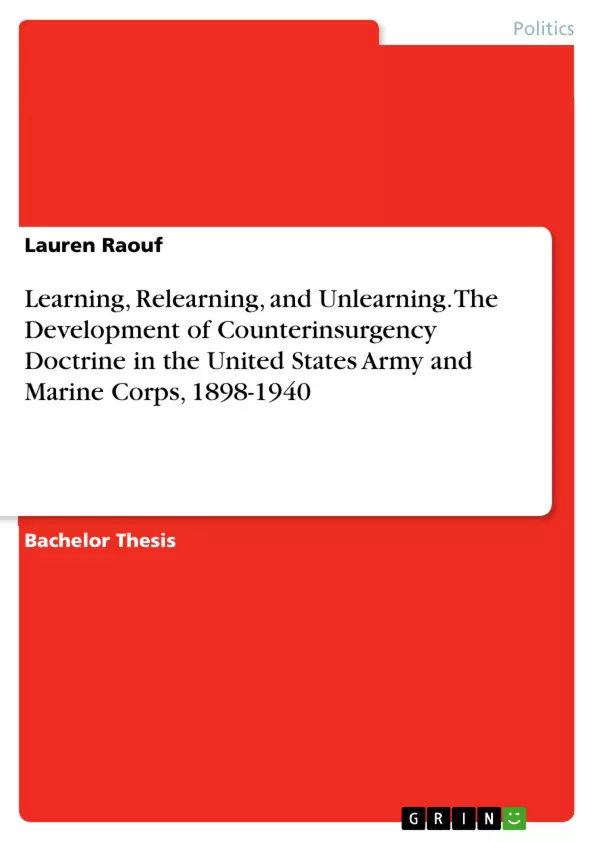The present thesis examines the factors that led to the development of counterinsurgency doctrine in the United States Army and Marine Corps, focusing on the period from 1898-1940, and why the two organizations had strikingly different approaches and beliefs about the importance of this doctrine.
When the Prussian military theorist Carl von Clausewitz described war as “simply a continuation of political intercourse, with the addition of other means,” he was writing primarily with reference to conventional warfare between the national armies fighting for the achievement of a specific set of political objectives. However, Clausewitz's understanding of war is equally applicable to a different kind of warfare: revolutionary warfare, defined by John Shy and Thomas Collier as “the seizure of political power by the use of armed force.” In this type of warfare, the insurgent force attempts to gain political power (usually the power of the state) while the counterinsurgent force—usually the state, although sometimes supported by outside actors—attempts to retain its hold on political power. Revolutionary war is at its heart a struggle for the support of the people, an explicitly political kind of warfare.
The problems of waging a successful counterinsurgency have plagued military experts for centuries. In a counterinsurgency, the strengths of a conventional military power are turned into weaknesses, as applying overwhelming force is generally counterproductive to the goal of winning popular support. For most conventional military forces, fighting a counterinsurgency
means changing the organization's very way of thinking about warfare. Military organizations known for their technological and conventional warfare prowess are forced to adopt new strategies and ideas when faced with the harassing tactics of
insurgents who need only strike when it suits them, while the counterinsurgent force must defend everything, everywhere, at all times. Isolating the insurgents from the population becomes the foremost goal of the counterinsurgency, requiring a delicate and shifting balance of offensive, defensive, and political operations often quite separate from the normal scope of military training and preparation.
Inhaltsverzeichnis (Table of Contents)
- Introduction: The Special Problems of Counterinsurgency
- Why Do Military Organizations Develop Doctrine, Anyway?
- Types of Doctrine
- Literature Review
- Methodology
- Remembering, Relearning, and Unlearning
- The Army and Counterinsurgency Doctrine, 1898-1940
- Historical Background
- Wars in the Philippines
- The Army at Home
- Learning, Relearning, and Formalizing
- The Marine Corps and Counterinsurgency Doctrine, 1898-1940
- Historical Background
- Wars in Haiti, the Dominican Republic, and Nicaragua
- Reaching Comprehensive Formal Counterinsurgency Doctrine
- Putting the Cases Together
- The challenges of counterinsurgency warfare and the unique problems it presents for conventional military forces.
- The evolution of counterinsurgency doctrine within the Army and Marine Corps.
- The factors that influenced the development of formal counterinsurgency doctrine, particularly in the Marine Corps.
- The contrasting approaches to doctrinal development between the Army and Marine Corps.
- The significance of these developments for understanding the history of counterinsurgency warfare and its impact on military organizations.
- Introduction: The Special Problems of Counterinsurgency: This chapter introduces the concept of counterinsurgency warfare, highlighting its unique challenges and the difficulties faced by conventional military forces in adapting to its demands. It also provides a brief overview of the thesis's scope and methodology.
- Why Do Military Organizations Develop Doctrine, Anyway?: This chapter explores the nature and purpose of military doctrine, examining different types of doctrine and the factors that influence its development. It also discusses the literature review and methodological approaches used in the thesis.
- Remembering, Relearning, and Unlearning: This chapter focuses on the Army's experiences with counterinsurgency from 1898 to 1940, examining its historical background, its involvement in the Philippine-American War, and its efforts to adapt to the challenges of counterinsurgency warfare.
- Learning, Relearning, and Formalizing: This chapter examines the Marine Corps' experiences with counterinsurgency during the same period, focusing on its historical background, its involvement in conflicts in Haiti, the Dominican Republic, and Nicaragua, and its eventual development of a comprehensive formal counterinsurgency doctrine.
- Putting the Cases Together: This chapter compares and contrasts the experiences of the Army and Marine Corps, analyzing the factors that led to the Marine Corps' development of formal doctrine while the Army remained largely focused on conventional warfare.
Zielsetzung und Themenschwerpunkte (Objectives and Key Themes)
This thesis examines the development of counterinsurgency doctrine in the United States Army and Marine Corps from 1898 to 1940. It investigates how these organizations learned from their experiences in a series of counterinsurgencies, focusing on the differences in their approaches to doctrinal development.
Zusammenfassung der Kapitel (Chapter Summaries)
Schlüsselwörter (Keywords)
Counterinsurgency, military doctrine, US Army, US Marine Corps, Philippine-American War, Haiti, Dominican Republic, Nicaragua, Small Wars Operations, Small Wars Manual, conventional warfare, revolutionary warfare, insurgency, guerrilla warfare.
- Quote paper
- Lauren Raouf (Author), 2008, Learning, Relearning, and Unlearning. The Development of Counterinsurgency Doctrine in the United States Army and Marine Corps, 1898-1940, Munich, GRIN Verlag, https://www.grin.com/document/321077



